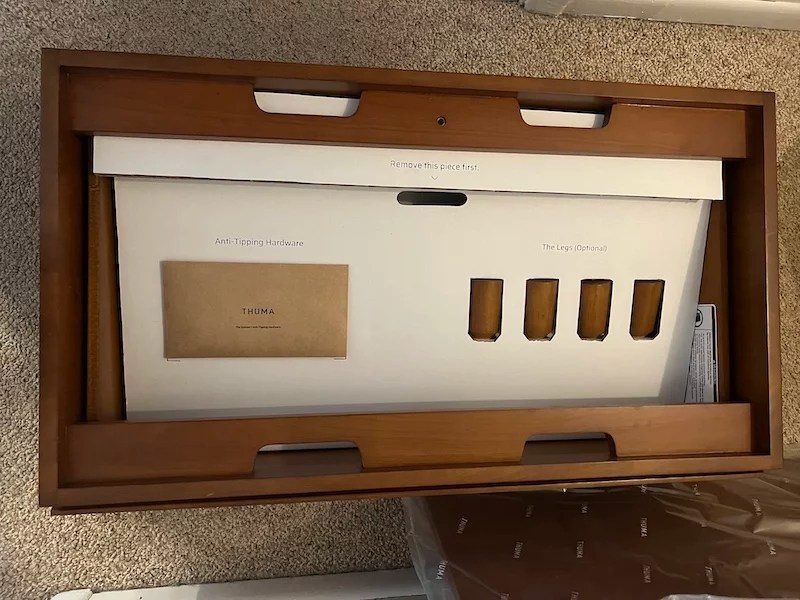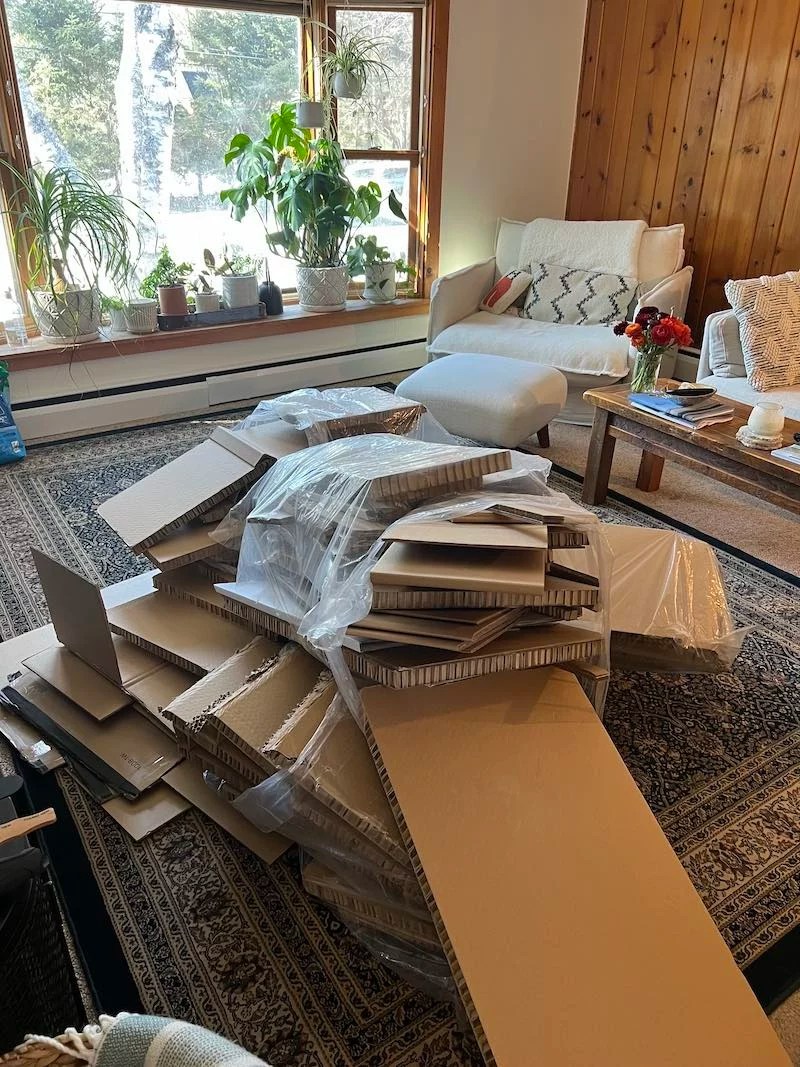I know I’m getting old because I can’t stand building boxed furniture anymore. For whatever reason, I used to take great satisfaction in wandering through Ikea, picking out a new desk or dresser, and then spending hours figuring out how to put it together while I binged my favorite podcast or reruns of Seinfeld. For me, it was like adult Legos!
But over the years, all the assembling and fighting with pieces and trying to decipher crappy manual illustrations (why aren’t there just words?) has really lost its luster. For starters, who has the time?! But also the quality of these pieces don’t hold up. The last piece I put together—a cheap work desk from Wayfair—is starting to sag (!?) below my laptop and monitor. Meanwhile, the cabinet underneath was never assembled correctly so the door doesn’t properly shut, nor does the sliding drawer on top align in its sliders without some serious jostling—oops.
Like everyone else with an Instagram account, I’ve seen ads for Thuma whilst scrolling through my feed. I had heard wonderful things about the brand’s ridiculously easy-to-put-together bed frame, but I didn’t know it sold other furniture that was just as simple to put together. In fact, most of it barely needs to be put together at all—products like The Dresser (prices start at $745) come pre-assembled, so all you have to do is stack its drawers on top of one another. Seems like a dream for people who have outgrown the painstakingly complicated Ikea configurations, no?
A little about Thuma
As mentioned, you’ve probably stumbled across an extremely aesthetic Thuma ad or two on Instagram. The brand is known for its “perfect platform bed” aptly named The Bed (prices start at $895) that requires no tools to assemble. (We loved it so much we reviewed it—read the full Thuma bed frame review here.) This means no cheap Alan wrenches or janky bags of hardware to put the pieces together. Rather, the Thuma uses Japanese joinery to connect the pieces in a sturdy, sleek design in sheer minutes.
Since the success of The Bed, Thuma has expanded with an array of other dreamy bedroom furnishings, including bedding and mattresses, headboards, nightstands, and…The Dresser.

Thuma, The Dresser
Prices start at $745 and vary per configuration and color.
Dimensions: Drawers measure out at 30″x15″x5″
Configurations: 8
Colors: 3
- Easy to assemble
- Premium quality
- Sleek and minimalist
- Lifetime warranty
- Sustainable
- Modular
- Pricey
- Packaging is wasteful (but also, it’s hard to mitigate this problem)
Like The Bed, The Dresser is made to streamline assembly, sans tools or overcomplicated instructions. There are currently eight configurations to choose from, although they’re modular, and can be easily moved or expanded upon need be. Each of the drawers arrive pre-assembled, making configuration painless.
To see just how easy The Dresser really is to set up, I tested the 4×1 configuration in walnut. Here’s everything you need to know about this seriously simple piece of furniture, from delivery through assembly.
Thuma review: The Dresser
Delivery
My dresser arrived at my doorstep in four large, heavy boxes. The boxes are bulky—I needed my boyfriend, Zac, to help me carry them inside. It makes sense considering each drawer of the Dresser—a solid, 30” x 15” x 5— comes packaged fully built and ready to go.
Getting the boxes inside was the only time I needed Zac’s help—everything was smooth sailing from there.

Assembly
Assembling this bad boy was easy peasy—I kept saying to Zac, “I can’t believe that’s it,” after completing it. It took me 15 minutes to put together, tops. All you have to do is unbox each drawer, screw in a piece on the back (you can use your hands, remember: no tools), and stack ’em up.
I opened the first box and found the first, fully built drawer, plus optional legs, anti-tipping hardware, and a very easy-to-follow manual. I opted to go with the legs, which took approximately one minute to screw onto the bottom the bottom drawer. Then, I simply carried the drawer to where I wanted it to go and placed it down. Done.
The exact same steps apply for the second, third, and fourth drawers (this can be more or less, depending on the configuration you purchase), only with these, there are no legs. Instead, the only extra step is a screw in the back of each drawer, which connects the drawers to one another.
One by one, I stacked each drawer on top of the next one, making sure the corners were fully nested and aligned with the one underneath so that the screw would go in even and straight. Again, this took maybe two minutes each, the hardest part being carrying and lifting the drawer to where you wanted it to go.

After securing the final drawer to my dresser, I grabbed the last piece, the top, and slid it over the top drawer, making sure the top tray properly nested inside to cover it completely. And that’s it! My stunning Thuma Dresser was built in 15 minutes flat.
Some notes on assembly:
- I really appreciated how easy and explicit the instructions are for unboxing each piece. They’re pretty clunky, and there’s a lot of packaging (and it’s all pretty tight), so getting them out can be confusing. Luckily, the boxes are printed with labels like, “Remove this piece first” to make getting them out easy breezy.
- The drawers are heavy, however, they come with built-in hand grips to make carrying them on your own easy. A thoughtful touch!
- I didn’t attach the anti-tipping hardware to my dresser, which might take extra time. It is recommended to install the hardware (which does require tools) to prevent tipping or injury, but for the sake of this piece, I wanted to see how long it took to install without it. User discretion advised.
Quality and price
I’m so impressed with The Dresser that I want to re-decorate my bedroom in all-things Thuma. A large part of it has to do with the minimalist, no-frills design. There are no additional knobs or drawer-pulls, so it’s sleek and utilitarian. Thuma’s materials are much higher quality than my other furniture from brands like Wayfair and Ikea, which makes sense, as those pieces are made from manufactured wood, a cheaper alternative to traditional lumber. The Dresser is made entirely from upcycled wood, which is definitely more expensive than manufactured wood, but more eco-friendlier than virgin lumber.

With the smallest walnut 2×2 dresser starting a $745, the price definitely reflects the quality of the materials. But it’s absolutely worth it, in my humble opinion.
Here’s why:
- The dresser *really* comes fully assembled, so it takes all the hard work out from you. All you have to do is unbox it and set it up.
- It feels high quality, and not just because of the wood. The pull curvatures of each drawer adds an upscale touch, while the soft-close drawers slide in and out with ease. (No wonky hinges or misaligned drawer slamming, ever.)
- The dresser is completely modular, meaning it’s easy to move or add pieces to, need be.
- It’s backed by a lifetime warranty. (More on that below.)
Sustainability
Thuma’s tagline is “forever furniture,” which alludes to the quality of its pieces that are crafted to last a lifetime and have the warranty to match. In a capitalist world where more is more, but not necessarily better, this is important. Yes, the Thuma’s prices are higher than retailers like Wayfair and Ikea, but the pieces are built to last, keeping them in your home and out of landfills.
The cool thing about The Dresser is that it’s built to last, even when you need to upsize or downsize. Since the pieces are modular, you can add or remove drawers if need be. Rather than dumping your old dresser completely and buying a new one, you can customize it to your needs, whether that’s downsizing to a new apartment, sharing a space with a significant other, or needing more room to accommodate more stuff.
On top of a lifetime warranty and upcycled materials, many Thuma products (including The Dresser) are GreenGuard Gold certified. This means they meet rigorous standards for chemicals and off-gassing VOCs (volatile organic compounds) to lower emissions. Additionally, Thuma plants a tree for every bed, dresser, nightstand, and headboard purchased through One Tree Planted to help reforestation efforts around the world. You can read more about Thuma’s sustainability efforts here.
That said, The Dresser comes with a lot of waste. I’m not kidding when I say bagging up and finding a place to store all of the empty packaging (a mix of cardboard, paper, and plastic) until trash/recycling came was daunting. Granted, the majority was cardboard, which is recyclable and one of more eco-friendly options for shipping. Still, only about 68 percent of all cardboard discarded actually gets recycled, so it makes you wonder.

Final thoughts
There’s a reason Thuma is so popular, on and off Instagram: It’s worth the hype. Cheap, DIY furniture has its place, but for those who have outgrown it like me and can afford buying something of higher quality, The Dresser is worth it. The simplicity of the pre-assembly alone is worth its weight in gold, and it’s built to last you a lifetime. Your sanity and schedule will thank you.
Our editors independently select these products. Making a purchase through our links may earn Well+Good a commission.
